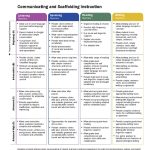Accommodations for Reading Comprehension: Breaking Down Barriers

Are you or someone you know struggling to grasp the meaning behind written text? Do you find yourself getting lost in a sea of words, unable to stay afloat? Well, you’re not alone, and there’s good news – there are accommodations for reading comprehension that can help.
In this article, we’ll dive into the world of reading comprehension accommodations, exploring what they are, why they’re necessary, and most importantly, how they can be implemented to help you or your loved one better understand written text.
What are Accommodations for Reading Comprehension?
Accommodations for reading comprehension refer to the strategies and techniques used to help individuals with learning difficulties, disabilities, or language barriers to better understand written text. These accommodations can be implemented in various settings, including schools, workplaces, and even at home.
Accommodations for reading comprehension can be categorized into several types, including:
- Assistive Technology: Software and devices that help individuals with reading difficulties, such as text-to-speech software, audiobooks, and e-readers with accessibility features.
- Visual Aids: Graphics, diagrams, and illustrations that complement written text, helping individuals to better visualize and understand complex concepts.
- Multilingual Support: Translation software and bilingual instructors that assist individuals with language barriers to access written text in their native language.
- Simplified Language: Using clear and concise language, avoiding jargon and technical terms that may be difficult to understand.
Why are Accommodations for Reading Comprehension Necessary?
Accommodations for reading comprehension are necessary because they help individuals with diverse learning needs to access written text and grasp its meaning. Without these accommodations, many individuals may struggle to keep up with their peers, leading to frustration, low self-esteem, and decreased academic and professional performance.
Implementing Accommodations for Reading Comprehension
So, how can accommodations for reading comprehension be implemented? Here are some strategies that can be used in various settings:
Accommodations for Reading Comprehension in Schools
Teachers can implement the following accommodations for reading comprehension in the classroom:
- Visual Aids: Using diagrams, charts, and illustrations to complement written text.
- Multilingual Support: Providing bilingual instructors and translation software to support students with language barriers.
- Assistive Technology: Integrating text-to-speech software and e-readers with accessibility features into the curriculum.
Accommodations for Reading Comprehension in the Workplace
Employers can implement the following accommodations for reading comprehension in the workplace:
- Assistive Technology: Providing employees with text-to-speech software and e-readers with accessibility features.
- Simplified Language: Using clear and concise language in written communication, avoiding jargon and technical terms.
Accommodations for Reading Comprehension at Home
Parents and caregivers can implement the following accommodations for reading comprehension at home:
- Visual Aids: Using diagrams, charts, and illustrations to complement written text.
- Assistive Technology: Providing text-to-speech software and e-readers with accessibility features.
Accommodations for Reading Comprehension: Tips and Tricks
Here are some additional tips and tricks to help you implement accommodations for reading comprehension:
- Break Down Complex Text: Breaking down complex text into smaller chunks can help individuals to better understand written text.
- Use Graphic Organizers: Graphic organizers can help individuals to visualize complex concepts and relationships.
- Provide Extra Time: Providing extra time to complete reading assignments can help individuals to better understand written text.
Benefits of Accommodations for Reading Comprehension
The benefits of accommodations for reading comprehension are numerous. By implementing these accommodations, individuals can:
- Improve Reading Comprehension: Accommodations for reading comprehension can help individuals to better understand written text.
- Increase Confidence: By providing individuals with the support they need, accommodations for reading comprehension can help to increase confidence and self-esteem.
- Enhance Academic and Professional Performance: By improving reading comprehension, accommodations for reading comprehension can help individuals to enhance their academic and professional performance.
Overcoming Barriers to Accommodations for Reading Comprehension
Despite the benefits of accommodations for reading comprehension, there are still barriers that prevent their implementation. These barriers include:
- Lack of Awareness: Many individuals are unaware of the accommodations for reading comprehension that are available.
- Lack of Resources: Some individuals may not have access to the resources they need to implement accommodations for reading comprehension.
Conclusion
Accommodations for reading comprehension are essential for individuals with diverse learning needs to access written text and grasp its meaning. By implementing these accommodations, we can help individuals to improve their reading comprehension, increase their confidence, and enhance their academic and professional performance.
Accommodations for reading comprehension are not a one-size-fits-all solution, but rather a tailored approach that meets the unique needs of each individual. By working together, we can break down barriers and ensure that everyone has equal access to written text.
Closing
Accommodations for reading comprehension are a lifeline for individuals who struggle to understand written text. By implementing these accommodations, we can help individuals to unlock their full potential and reach new heights.
<